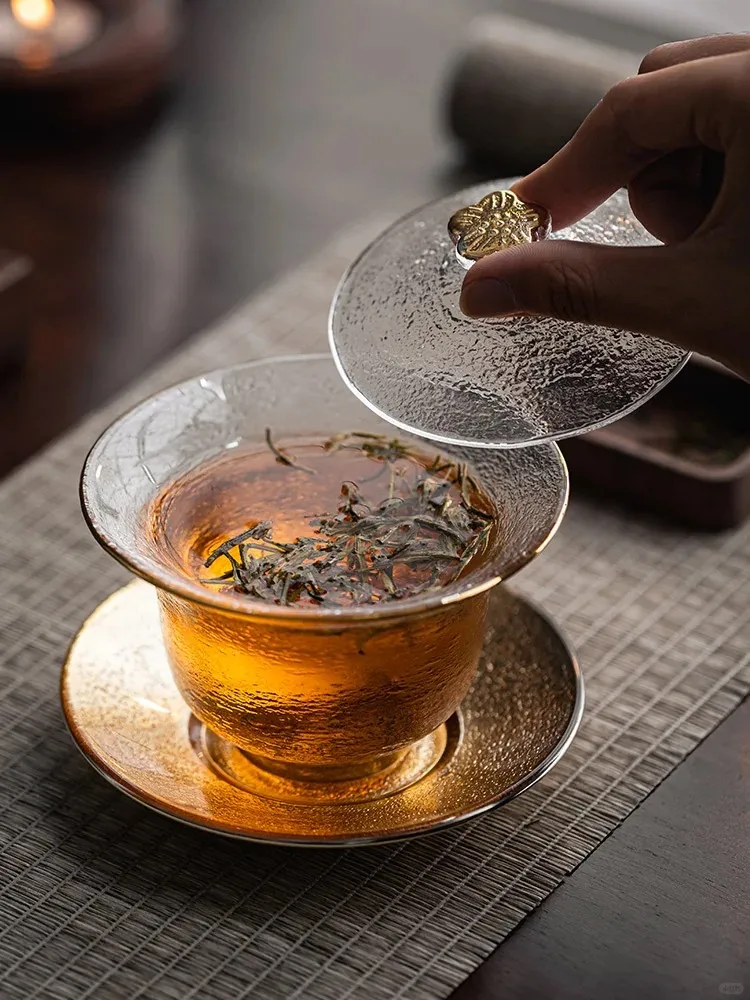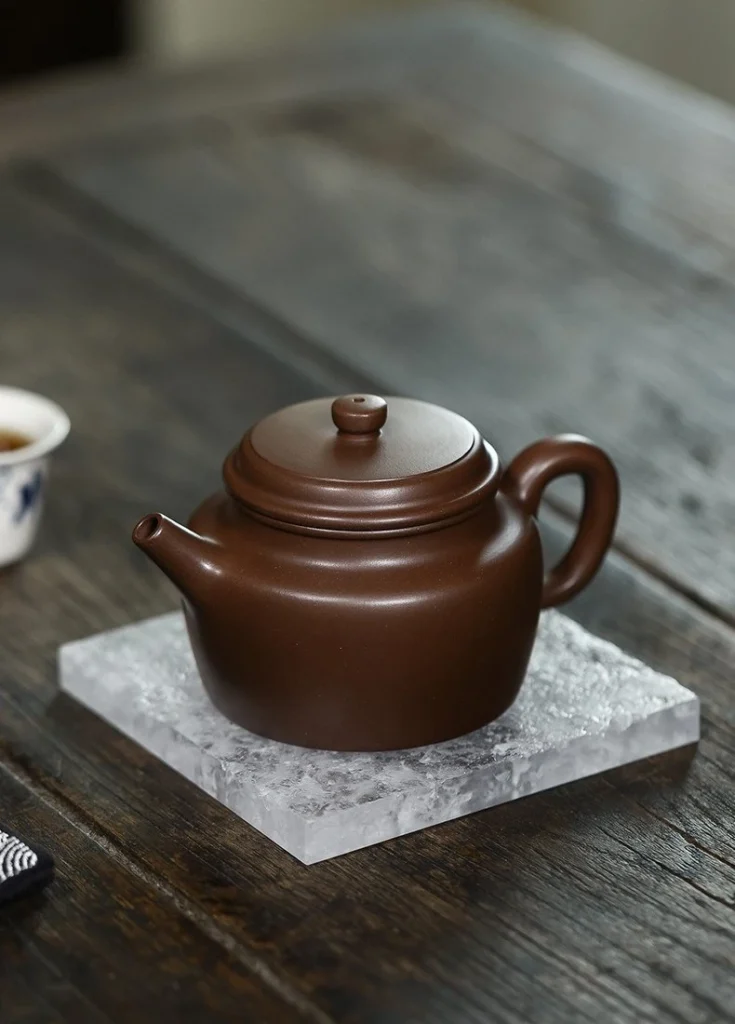Tea enthusiasts worldwide are constantly seeking new ways to enhance their tea-drinking experience. Two popular brewing vessels that often spark debate are the glass gaiwan and traditional teapots. In this comprehensive guide, we’ll explore the unique characteristics of each, helping you decide which might be the perfect fit for your tea ritual.
The Allure of the Glass Gaiwan
The glass gaiwan, also called a crystal glass gaiwan or high-transparency glass gaiwan, is a modern twist on the traditional Chinese tea brewing vessel. Combining the classic gaiwan design with the clarity of glass, it offers a visually stunning brewing experience, allowing you to observe the unfolding of tea leaves and the brewing process in a way that enhances the overall tea experience.
One of the most captivating aspects of a glass gaiwan tea set is its ability to showcase the tea leaves as they unfurl. The transparency allows you to observe the subtle color changes of the liquor and the graceful dance of the leaves as they steep. This visual feast adds an extra dimension to the tea-drinking experience, making it a taste sensation and a visual delight.

The high-transparency glass gaiwan is particularly adept at highlighting the beauty of flowering teas or teas with striking leaf shapes. Imagine watching a delicate jasmine pearl slowly blossom or observing the long, elegant leaves of a high-grade Dragonwell green tea as they gracefully sway in hot water. This visual aspect can transform a simple cup of tea into a mesmerizing performance.
In addition to its aesthetic charm, the glass gaiwan offers practical advantages. Made from heat-resistant borosilicate glass, it provides excellent heat retention while staying cool to the touch on the outside. This makes it easy and comfortable to handle, even when brewing hot teas, ensuring a pleasant and safe tea-brewing experience without the risk of burns or discomfort.
Additionally, the neutral properties of glass prevent it from absorbing flavors or aromas from previous brews. This makes the glass gaiwan an excellent choice for tea enthusiasts who enjoy exploring different teas, as it ensures each brew remains pure and free from flavor contamination. With a glass gaiwan, you can savor every tea’s true essence without lingering aftertaste from previous infusions.
The Timeless Charm of Traditional Teapots

While the glass gaiwan offers a contemporary twist on tea brewing, traditional teapots have stood the test for good reason. These vessels, often made from clay, porcelain, or cast iron, bring unique qualities to the tea-brewing process.
Clay teapots, particularly those made from Yixing clay, are prized for absorbing the flavors and aromas of the teas brewed in them over time. This seasoning process can enhance the complexity of your tea, adding subtle nuances to each brew. Many tea connoisseurs dedicate specific clay teapots to particular types of tea to fully develop these flavor profiles.
Porcelain teapots, on the other hand, offer a neutral brewing environment similar to glass. They’re excellent for preserving the pure, unadulterated flavors of delicate teas. The smooth, non-porous surface of porcelain also makes these teapots easy to clean and maintain.
Cast iron teapots, or tetsubins, are renowned for their superior heat retention properties. They’re particularly well-suited for brewing teas that benefit from consistent, high temperatures, such as certain oolong or pu-erh varieties. The sturdy nature of cast iron also means these teapots can last for generations, becoming cherished family heirlooms.
Traditional teapots often come in sizes, from small single-serving pots to large vessels designed for group tea sessions. This versatility makes them suitable for multiple tea-drinking scenarios, from solitary contemplation to lively social gatherings.
Choosing Between Glass Gaiwan and Traditional Teapots
Consider your tea-drinking preferences and habits when deciding between a glass gaiwan and a traditional teapot. If you’re a visual person who enjoys watching the brewing process or frequently samples different types of tea, a high-transparency glass gaiwan might be a perfect choice. Its versatility and ease of cleaning make it an excellent option for tea explorers.
On the other hand, if you have a favorite type of tea you drink regularly, a traditional teapot might be more suitable. The ability to season clay teapots or the excellent heat retention of cast iron can significantly enhance your enjoyment of certain teas.
Consider also the types of tea you prefer. Delicate green and white teas often shine in a glass gaiwan, where their subtle flavors and aromas can be fully appreciated without interference. Robust black teas or aged pu-erhs might benefit from a clay teapot’s seasoning effect or cast iron’s heat retention.
Your brewing style is another factor to consider. If you enjoy the precise control over the steeping time the gaiwan offers, a glass gaiwan might be your ideal tool. A traditional teapot might be more convenient if you prefer a more relaxed approach or often brew large quantities of tea.
Conclusion
Ultimately, choosing between a glass gaiwan and a traditional teapot doesn’t have to be an either-or decision. Many tea enthusiasts enjoy using both, selecting the most appropriate vessel for each tea session based on the tea variety, mood, and occasion.
Whether you choose the modern elegance of a crystal glass gaiwan or the time-honored tradition of a classic teapot, remember that the most important aspect of tea brewing is the enjoyment it brings. Experiment with different vessels, find what works best for you, and savor the rich world of flavors tea offers.
We serve thousands of satisfied tea enthusiasts in our tea house each year, and we’re excited to share these exceptional teas with tea lovers worldwide at Orientaleaf.com.

References
- Heiss, M. L., & Heiss, R. J. (2007). The Story of Tea: A Cultural History and Drinking Guide. Ten Speed Press.
- Pettigrew, J. (2001). The Tea Companion: A Connoisseur’s Guide. Running Press.
- Ukers, W. H. (1935). All About Tea. The Tea and Coffee Trade Journal Company.
- Yu, L. (2014). The Classic of Tea: Origins and Rituals. Ecco Press.
- Gascoyne, K., Marchand, F., Desharnais, J., & Américi, H. (2011). Tea: History, Terroirs, Varieties. Firefly Books.

